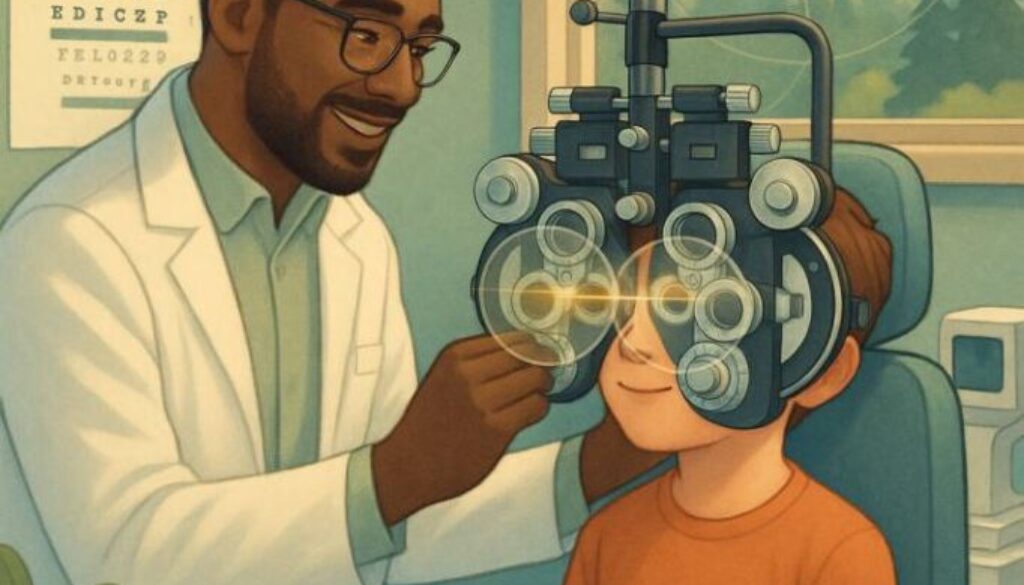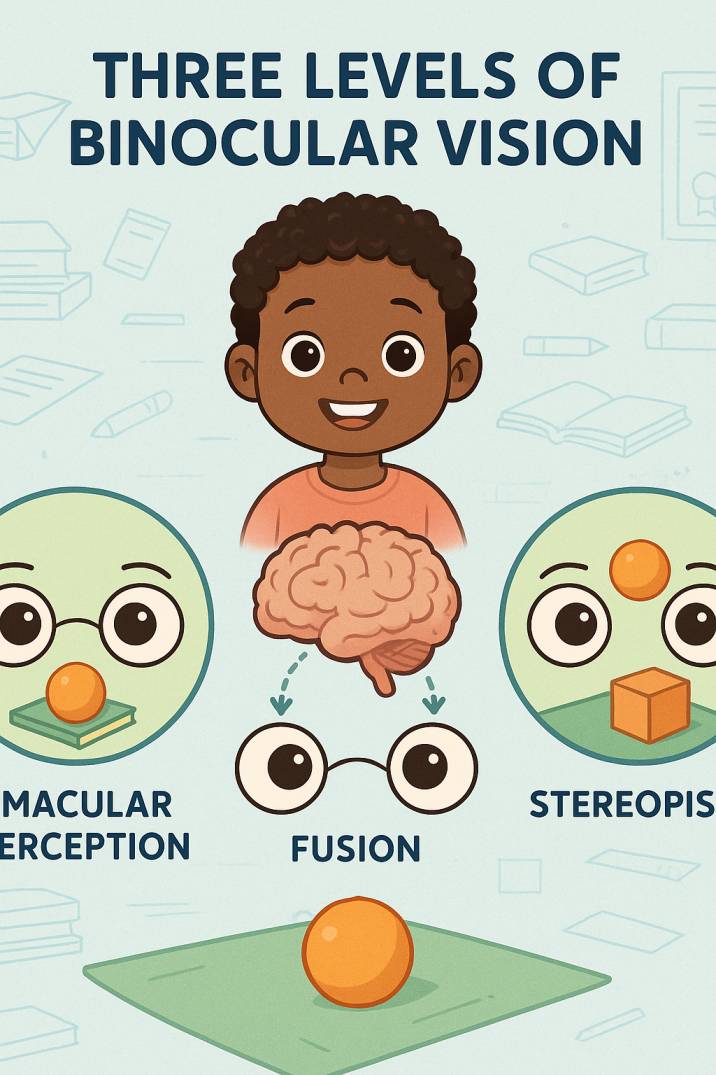Binocular Vision Problems Kids: Complete Parent Guide
At a Glance: Nearly one in four children experiences binocular vision problems that can profoundly impact their learning, reading, and academic success. While standard vision screenings focus on whether your child can see 20/20, binocular vision examines how effectively both eyes collaborate as a unified team. Through early detection and evidence-based vision therapy, success rates of 75-87% can be achieved in addressing these critical developmental issues.
Understanding Binocular Vision: Beyond Perfect Sight
When considering children’s vision health in Fort Collins, most parents naturally focus on visual clarity—can their child see the chalkboard or read without straining their eyes? However, binocular vision encompasses far more than basic visual acuity. It represents the sophisticated neurological process through which your child’s brain seamlessly integrates information from both eyes, creating a single, clear, three-dimensional image with accurate depth perception.
At Poudre Valley Eyecare, we frequently encounter children whose academic challenges stem from undiagnosed binocular vision dysfunction, despite demonstrating perfect 20/20 visual acuity during standard screenings.
The Architecture of Binocular Vision
Binocular vision functions through three progressively sophisticated levels:
- Macular Perception: The foundational level where both eyes simultaneously focus on the same object with clarity, utilizing the central portion of each retina (the macula) for optimal detail recognition.
- Fusion: An intermediate process wherein your child’s brain skillfully combines separate images from each eye into a single, cohesive visual experience, ensuring that overlapping visual fields align with precision.
- Stereopsis: The most advanced capability, providing true three-dimensional vision and accurate depth perception by interpreting the subtle differences between what each eye perceives.
When any component of this intricate system malfunctions, children may experience difficulties with seemingly unrelated activities, including reading fluency, handwriting accuracy, athletic performance, and sustained classroom attention.
The Scope of Impact: Understanding the Prevalence
Contemporary research reveals concerning statistics regarding binocular vision dysfunction in pediatric populations:
- Up to 25% of all children experience binocular vision problems that affect ocular function (supported by multiple peer-reviewed studies from 2024)
- Up to 50% of children diagnosed with ADD/ADHD may have underlying, undiagnosed binocular vision dysfunction
- 74% of symptomatic patients evaluated at specialized vision therapy clinics demonstrate measurable binocular vision dysfunction (2024 multicenter study)
- Binocular vision problems occur 9.7 times more frequently than ocular disease in children aged 6 months to 5 years.
- 8.5 times more prevalent than diagnosed eye diseases in children aged 6-18 years (National Institutes of Health data)
These findings suggest that binocular vision dysfunction may be silently compromising your child’s educational experience and quality of life, often without recognition by parents, teachers, or even healthcare providers.
Recognizing the Warning Signs: When Perfect Vision Isn’t Enough
Numerous children with binocular vision dysfunction pass standard vision screenings with flying colors because they demonstrate excellent letter recognition on traditional eye charts. However, these conventional assessments fail to evaluate how effectively the eyes function as a coordinated team. As Fort Collins’ trusted eye care professionals with over 25 years of clinical experience, we guide parents in identifying these subtle yet significant warning indicators:
Academic and Cognitive Symptoms
- Reading comprehension difficulties despite demonstrated intelligence and verbal abilities
- Unusually slow reading pace or the need to repeatedly read paragraphs for comprehension
- Reading comprehension scores that fail to match demonstrated verbal capabilities
- Frequent word or line omissions during reading activities
- Challenges copying information from distant surfaces (such as whiteboards) to paper
- Active avoidance of homework or reading-related tasks
- Markedly shortened attention span during visually demanding activities
Physical and Physiological Indicators
- Recurring headaches following reading or academic work
- Visual fatigue or eye strain during close-range activities
- Squinting or monocular closure (closing one eye) while reading
- Excessive blinking patterns or frequent eye rubbing
- Compensatory head positioning (tilting) for comfortable reading
- Preference for unusual proximity to books or digital devices
Behavioral and Motor Development Signs
- Frequent clumsiness or unexpected contact with objects
- Inconsistent handwriting quality with irregular spacing patterns
- Challenges with ball sports or poor hand-eye coordination
- Motion sensitivity in vehicles or on playground equipment
- Anxiety in crowded environments or when navigating stairs
Clinical Classifications: Understanding the Three Categories
Eye care professionals systematically categorize binocular vision dysfunction into three primary classifications:
1. Accommodative Dysfunction (Focusing Disorders)
Children experiencing accommodative dysfunction struggle with the eye’s ability to adjust focus across varying distances or transition smoothly between near and distant targets.
- Accommodative Insufficiency: Characterized by inadequate focusing ability for close-range tasks, resulting in blurred vision during reading or homework completion.
- Accommodative Excess: Manifested as over-focusing, which generates eye strain and cephalgia (headaches) during sustained near work.
- Accommodative Infacility: Demonstrated difficulty transitioning focus between distances, such as alternating attention between desk materials and classroom displays.
2. Vergence Dysfunction (Eye Coordination Disorders)
Vergence disorders compromise the eyes’ ability to coordinate movement and maintain proper alignment when focusing on targets at various distances.
- Convergence Insufficiency: The most frequently encountered type, affecting approximately 15% of the general population. Children experience difficulty with inward eye movement during reading activities, resulting in diplopia (double vision), ocular strain, and cephalgia after brief periods of near work (typically 5-10 minutes).
- Convergence Excess: Characterized by excessive inward eye movement when focusing on close objects, producing symptomatology similar to convergence insufficiency.
- Divergence Dysfunction: Manifested as difficulty maintaining appropriate eye alignment when viewing distant targets.
3. Oculomotor Problems (Eye Movement Issues)
These problems affect smooth, accurate eye movements necessary for reading and visual tracking.
- Pursuit Problems: Difficulty following moving objects smoothly, affecting sports performance and reading fluency.
- Saccadic Problems: Trouble making accurate eye jumps between words or from line to line while reading, leading to lost place or skipped words.
The Educational Connection: Impact on Academic Performance
Groundbreaking research conducted at the University of Waterloo demonstrated that elementary school children performing below grade level in reading frequently exhibit binocular vision dysfunction, even when demonstrating perfect 20/20 visual acuity. Dr. Lisa Christian’s landmark investigation revealed:
- 81% of children experiencing reading difficulties demonstrated no significant refractive error
- 90% maintained normal distance eye alignment, yet exhibited problematic near vision coordination
- Children could identify individual words but struggled with the sustained binocular coordination essential for fluent reading.
The relationship between vision and learning extends far beyond simple sight. Research indicates that 80% of classroom-based learning occurs through the visual system, requiring the integration of 17 distinct visual skills for academic success, with 20/20 visual acuity representing merely one component of this complex system.
The Challenge of Misdiagnosis
The symptomatic overlap between binocular vision dysfunction and other developmental conditions frequently results in misdiagnosis. Children are commonly identified with:
- Specific learning disabilities
- Attention Deficit Hyperactivity Disorder (ADHD)
- Dyslexia
- Behavioral disorders
- Developmental delays
A comprehensive 2024 research study demonstrated that children with binocular vision dysfunction were significantly more likely to receive diagnoses of learning disabilities and ADHD compared to children with normal binocular function, underscoring the critical importance of comprehensive vision evaluations in educational settings.
Causes and Risk Factors
Understanding what contributes to binocular vision problems can help parents recognize potential issues early:
Developmental Factors
- Facial asymmetry (even subtle differences)
- Premature birth and associated developmental delays
- Delayed visual system maturation
- Genetic predisposition to vision problems
Environmental Factors
- Excessive screen time affects eye muscle development
- Head injuries or concussions from sports or accidents
- Poor visual habits during critical development periods
- Insufficient outdoor time contributes to visual system stress
Modern Lifestyle Impacts
Recent research shows concerning trends related to digital device usage:
- Children using digital devices show reduced accommodative facility
- Decreased accommodative amplitude with increased screen exposure
- Reduced positive fusional vergences affecting eye teaming ability
These findings suggest that our technology-heavy lifestyle may be contributing to increased rates of binocular vision problems in children.
Professional Consultation in Fort Collins: Comprehensive Diagnostic Approach
Standard educational vision screenings assess visual acuity (clarity of sight for each eye) but rarely evaluate binocular coordination and function. Comprehensive binocular vision assessment requires specialized testing protocols administered by experienced Fort Collins eye care specialists.
At Poudre Valley Eyecare, our thorough binocular vision evaluations extend far beyond basic vision screenings, systematically identifying the underlying causes of learning difficulties and reading challenges.
Comprehensive Assessment Components
A thorough binocular vision evaluation encompasses:
- Cover Test Analysis: Advanced techniques for detecting subtle eye alignment irregularities not apparent through casual observation
- Near Point of Convergence Measurement: Precise assessment of the closest distance at which objects can be brought toward the nose while maintaining single, clear vision
- Fusional Vergence Evaluation: Comprehensive testing of the eyes’ ability to maintain coordination under varying degrees of visual stress
- Accommodative Function Assessment: Detailed evaluation of focusing capabilities and flexibility across different distances
- Oculomotor Function Analysis: Systematic testing of pursuit (smooth following) and saccadic (rapid jumping) eye movement patterns
- Stereoscopic Acuity Testing: Measurement of three-dimensional depth perception accuracy and consistency
Advanced Diagnostic Tools
Modern optometry practices like Poudre Valley Eyecare use cutting-edge diagnostic technology to detect subtle binocular vision problems:
- Digital eye tracking systems that measure precise eye movements
- Computerized binocular vision analyzers provide objective measurements
- Specialized imaging to assess eye muscle function
- Comprehensive binocular vision protocols developed from the latest research
Therapeutic Interventions: Evidence-Based Treatment Approaches
The encouraging reality is that binocular vision dysfunction responds exceptionally well to appropriate intervention, particularly when identified and addressed during childhood. Treatment outcomes and associated costs vary according to the specific condition and therapeutic approach selected:
Vision Therapy: The Clinical Gold Standard
Office-based vision therapy has demonstrated remarkable efficacy across multiple peer-reviewed clinical trials:
- 75% success rate for convergence insufficiency (validated through the Convergence Insufficiency Treatment Trial and corroborated by numerous 2024 research studies)
- 87.5% success rate documented in recent Korean pediatric populations
- 73% sustained improvement rate with symptom resolution maintained one year post-treatment completion
Current Investment Requirements (2025):
- Individual therapy sessions: $125-$250 per appointment
- Comprehensive treatment programs: $1,500-$5,500 total investment (typically encompassing 20-30 sessions)
- Initial assessment procedures: $300-$500 for a complete binocular vision evaluation
Treatment Components Include:
- Supervised Clinical Sessions: Weekly appointments utilizing specialized equipment under professional supervision
- Home-Based Reinforcement Exercises: Daily activities designed to strengthen newly acquired visual skills
- Progress Assessment and Monitoring: Regular evaluations to track improvement trajectories and adjust therapeutic protocols
- Treatment Duration: Most programs require 12-24 weeks for optimal therapeutic outcomes
Corrective Lenses and Prisms
Specialized glasses can provide immediate relief:
- Micro-prismatic lenses reduce eye strain by correcting subtle misalignments
- Reading glasses for children with focusing problems
- Computer glasses to reduce digital eye strain
- Bifocal or progressive lenses for complex accommodation issues
Combined Treatment Approaches
The most effective treatment often combines multiple approaches:
- Corrective lenses for immediate symptom relief
- Vision therapy for long-term skill development
- Environmental modifications in the classroom and home settings
- Follow-up care to maintain progress
Recent Scientific Breakthroughs
2024 Research Highlights
- Digital Device Impact Study (Nepal): Research published in 2024 revealed that children using digital devices for more than 3 hours daily showed significant reductions in binocular vision parameters, including accommodative facility and positive fusional vergences.
- Reading Difficulties Study (Latvia): A December 2024 study found that children with reading difficulties were significantly more likely to have uncorrected refractive errors and binocular vision dysfunctions, even when they didn’t report visual symptoms.
- Dyslexia Connection Research (Nigeria): July 2024 research demonstrated a higher prevalence of binocular vision anomalies among children with dyslexia, supporting the connection between vision problems and learning difficulties.
Treatment Innovation
- Binocular Treatment for Amblyopia: New dichoptic therapies using special glasses and video games show promise for treating lazy eye while maintaining binocular function.
- Home-Based Therapy Systems: Advanced computer programs now allow effective treatment monitoring and delivery in home settings.
- Neuroscience Integration: Understanding of brain plasticity has led to more targeted therapy approaches with higher success rates.
Supporting Your Child: A Parent’s Action Plan
Immediate Steps
- Schedule a comprehensive eye exam with a developmental optometrist experienced in binocular vision.
- Document symptoms you’ve observed at home and school
- Communicate with teachers about potential vision-related learning challenges
- Manage screen time appropriately – research shows children using digital devices over 3 hours daily have significantly reduced binocular vision parameters
- Create optimal study environments with proper lighting and viewing distances
During Treatment
- Maintain consistency with vision therapy exercises and appointments
- Celebrate progress rather than focusing on perfect performance
- Communicate with the therapy team about changes in symptoms or behavior
- Advocate at school for appropriate accommodations during treatment
- Stay patient, as vision therapy requires time for the brain to develop new patterns
Long-Term Success
Research shows that children who complete binocular vision therapy maintain their improvements long-term. The 2024 CITT-ART study found that 1 year after treatment, children maintained their visual improvements, providing lasting benefits for academic success and quality of life.
The Fort Collins Advantage: Poudre Valley Eyecare’s Approach
With over 25 years of experience serving Northern Colorado families, Poudre Valley Eyecare brings unmatched expertise to pediatric binocular vision care. Our comprehensive approach includes:
- Advanced Diagnostic Technology: State-of-the-art equipment to detect subtle binocular vision problems that other practices might miss
- Experienced Pediatric Team: Specialists trained in the latest binocular vision assessment and treatment techniques
- Family-Centered Care: Treatment plans designed around your child’s specific needs and your family’s schedule
- Insurance Acceptance: Medicare and Medicaid coverage make quality care accessible to every family
- Community Commitment: Deep roots in Fort Collins with an understanding of local school systems and requirements
When to Seek Help: Don’t Wait for Problems to Worsen
Early intervention is crucial for binocular vision problems. The visual system is most responsive to treatment during childhood, when brain plasticity allows for rapid development of new visual skills.
We encourage Fort Collins parents to contact Poudre Valley Eyecare if their child demonstrates any of these indicators:
- Academic struggles despite demonstrated intellectual capability
- Complaints of headaches following homework or reading activities
- Poor athletic performance or unexpected clumsiness
- Avoidance of visual tasks or diminished attention span during near work
- Previous diagnoses of learning disabilities or ADHD
- Successful completion of school vision screenings despite ongoing academic difficulties
Additional Resources & Research Citations
Based on the comprehensive research conducted for this article, here are three key resources that provide valuable additional information for parents and professionals:
1. Convergence Insufficiency Treatment Trials (CITT) – National Eye Institute
Link: https://www.nei.nih.gov/learn-about-eye-health/eye-conditions-and-diseases/convergence-insufficiency
This landmark research program, funded by the National Eye Institute, established the gold standard for treating convergence insufficiency in children. The CITT studies definitively proved that office-based vision therapy achieves 75% success rates, making it the most effective treatment for this common binocular vision problem.
2. University of Waterloo – Binocular Vision and Reading Problems Study
Link: https://uwaterloo.ca/optometry-vision-science/
Dr. Lisa Christian’s groundbreaking research revealed that elementary school children reading below grade level frequently have binocular vision problems, even with perfect 20/20 vision. This study showed that 81% of children with reading difficulties had no significant refractive error but demonstrated binocular vision dysfunction.
3. American Optometric Association – Children’s Vision Development Guidelines
Link: https://www.aoa.org/healthy-eyes/eye-health-for-life/school-aged-vision
The AOA’s comprehensive guidelines outline the 17 visual skills essential for academic success, emphasizing that 20/20 vision represents just one aspect of complete visual function. Their evidence-based recommendations help parents understand when children need comprehensive binocular vision evaluations.
Conclusion: Investing in Your Child’s Visual and Academic Future
Binocular vision dysfunction affects millions of children nationwide, frequently masquerading as learning disabilities, attention disorders, or behavioral challenges. The encouraging reality remains that these conditions respond exceptionally well to appropriate treatment when properly diagnosed and addressed by experienced professionals.
We encourage parents not to allow undiagnosed binocular vision dysfunction to limit their child’s academic potential or overall quality of life. The investment in comprehensive vision care represents far more than routine eye care—it can fundamentally transform how your child perceives, learns, and experiences the world around them.
Ready to support your Fort Collins child’s success? Contact Poudre Valley Eyecare today to schedule a comprehensive binocular vision evaluation. With our quarter-century of clinical experience and unwavering commitment to accessible, community-focused care, we stand ready to support your family’s journey toward optimal vision and academic achievement.
FAQs
-
Binocular vision problems mean a child’s eyes struggle to work together, leading to symptoms like double vision, headaches, or difficulty focusing
Please note: None of the above should be considered medical advice. If you’re having any concerns about your vision, please reach out to us immediately or see your primary care provider.




